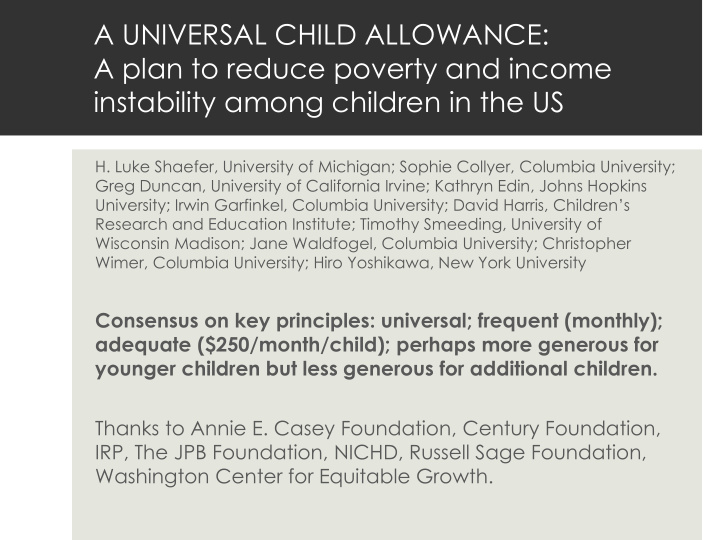



A UNIVERSAL CHILD ALLOWANCE: A plan to reduce poverty and income instability among children in the US H. Luke Shaefer, University of Michigan; Sophie Collyer, Columbia University; Greg Duncan, University of California Irvine; Kathryn Edin, Johns Hopkins University; Irwin Garfinkel, Columbia University; David Harris, Children’s Research and Education Institute; Timothy Smeeding, University of Wisconsin Madison; Jane Waldfogel, Columbia University; Christopher Wimer, Columbia University; Hiro Yoshikawa, New York University Consensus on key principles: universal; frequent (monthly); adequate ($250/month/child); perhaps more generous for younger children but less generous for additional children. Thanks to Annie E. Casey Foundation, Century Foundation, IRP, The JPB Foundation, NICHD, Russell Sage Foundation, Washington Center for Equitable Growth.
Figure 2 Child income poverty rates, 2012 a Share (%) of children (0-17) that live in households with an equivalised post-tax and transfer income of less than 50 percent of the national annual median equivalised post-tax and transfer household income Children (0-17) ( ) Total population Poverty rate (%) 30 25 20 15 10 5 0 Countries with some form of a child allowance: Austria, Belgium, Canada, Denmark, Finland, France, Germany, Iceland, Ireland, Luxembourg, the Netherlands, Norway, Sweden, Switzerland & U.K.
CHANGES IN THE SAFETY NET The U.S. has increased its financial commitment to fighting poverty substantially over the past half century through refundable tax credits and in-kind aid More aid is now directed to low-income working families Less aid to families who are unable to maintain stable employment Only ¼ of TANF dollars go toward basic assistance Other uses include child care subsidies and state EITCs. Very little is spent on helping recipients find work TANF was not responsive to the rise of poverty and unemployment during the Great Recession
This Is > Than These combined
WHY A MONTHLY CHILD ALLOWANCE? Increased income may allow parents to increase investments in children, improving child health/development Increased income may reduce family and environmental stress, which can improve child health and development Poverty can compromise parents’ cognitive “bandwidth,” with detrimental consequences for cognitive tasks and decision-making Families well up the economic ladder face substantial intra- year volatility in income and expenses Conceptual linkages between income and the child development suggest dependable monthly income support would have substantial benefits
BASING POLICY ON PRINCIPLES CONSENSUS The child allowance should be universal, recognizing that all families incur substantial expenses when raising children The allowance should be accessible and of sufficient frequency to meet short-term cash needs. We propose monthly distribution Payments should be adequate for a family to address basic needs of children—we recommend $250/ month IMPORTANT CONSIDERATIONS Families with younger children should be eligible for larger payments Per-child payments should decline with additional children
Three proposed versions of a child allowance Simple: Monthly payments of $250 per child per month for all children under age 18. Tiered: Monthly payments of $300 per child under age 6, $250 per child age 6- 17. Tiered and Equivalized: Monthly payments of $300 for the first child under age 6 and $250 for the first child age 6-17, with a reduction in these benefit levels as the number of children in the household increases. In each case, payments would be taxed at the marginal tax rate of the unit claiming the child.
Our 3 alternative models reduce poverty substantially – at a cost of $69-108 billion.
POVERTY EFFECTS (CPS ASEC)
Poverty Reductions would be Broad- Based
All Would Gain, but Larger Gains Would Accrue to the Most Disadvantaged
PAYING FOR IT Table 1: Cost Estimates of Universal Child Allowance Proposals (in billions) Total Direct Cost Cost Savings* Net Cost of CA: Universal $250/mo. CA $192 $96 $96 Tiered $250/$300/mo. CA $204 $96 $108 Tiered and equivalized CA $165 $96 $69 * Cost savings are the estimated results of eliminating the CTC, ACTC, and also the child exemption under federal tax law. Estimates provided by Elaine Maag at the Urban Institute’s Tax Policy Center, 2016. TPC estimates that the net cost of the Lee-Rubio Refundable CTC expansion would be $130 in 2015 TPC estimates that the net cost Clinton Refundable CTC expansion would cost $20 billion http://www.taxpolicycenter.org/publications/preliminary-analysis-family-fairness-and-opportunity-tax- reform-act/full
Effects are similar in California 25.00% 23.7% 20.8% 20.00% 16.8% 14.6% 15.00% 10.00% 5.00% 0.00% Overall Poverty Overall Poverty Child Poverty Rate Child Poverty Rate, Rate Rate, Post-Child Post-Child Allowance Allowance
Also for Deep Poverty 7.00% 6.5% 6.0% 6.00% 5.1% 5.00% 4.00% 2.9% 3.00% 2.00% 1.00% 0.00% Overall Deep Poverty Rate Overall Deep Poverty Rate, Child Deep Poverty Rate Child Deep Poverty Rate, Post-Child Allowance Post-Child Allowance
SUMMARY Child poverty in the U.S. remains stubbornly high Much of the benefit from the Child Tax Credit & Child Tax Exemption goes to families with incomes above poverty The work-based social safety net has expanded significantly Yet our most vulnerable families—who cannot maintain regular employment—can fall through the cracks, especially in terms of cash aid A stable source of income could reduce material hardship and improve child health and development We propose a universal, monthly child allowance to provide all children with a dependable cash income floor
CONCLUDING REMARKS Through the child tax exemption and child tax credit, our nation recognizes the societal benefit to supporting parents in raising children But our biggest policies exclude the lowest income families, and are not equitable Our universal child allowance would recognize that raising children is expensive It would provide a stable cash income flow for families struggling with intra-year income/expense volatility It would complement our work-based safety net And would dramatically reduce poverty Costs are not inconsequential, but so may be the benefits
Thanks This paper was originally prepared for a conference at Russell Sage Foundation. We are grateful to Russell Sage Foundation and to participants at the conference.
Recommend
More recommend